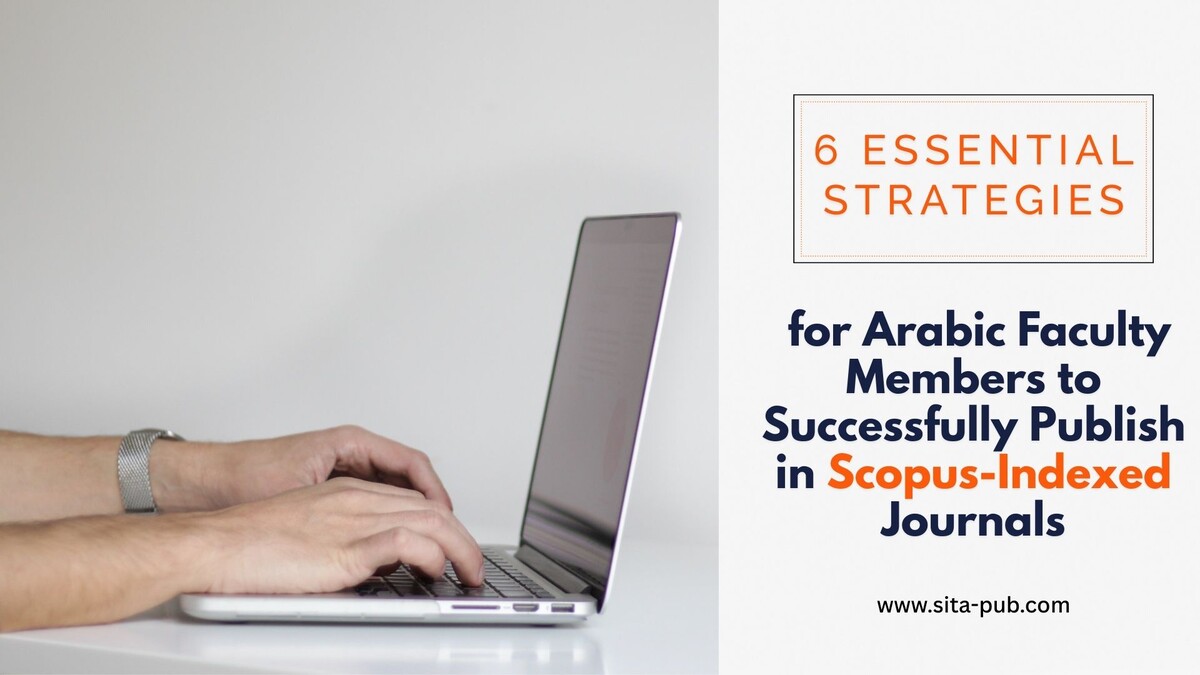6 Proven Strategies for Arabic Faculty Members | Publish in Scopus-Indexed Journals


The publication in scholarly journals is a great accomplishment for any academic, especially for those seeking career development. With a wealth of experience in offering publication support services, we have determined successful strategies as well as typical pitfalls in journal submission. Many researchers, specifically those in faculty positions, find it challenging to select appropriate journals, follow formatting styles, and respond to criticism from peer reviewers.
In this article, we share strategies that have helped countless researchers successfully navigate the complex process of publishing in Scopus-indexed and other reputable journals. We'll concentrate on critical aspects like choosing the right journal for your paper, ensuring that your manuscript follows formatting guidelines, and writing an engaging cover letter. We'll also go over how to handle revision requests effectively, turning feedback into an opportunity to improve your work.

Whether you're aiming for high-impact journals or faster publication in less competitive journals, our experience will guide you through the process. By following these tried-and-true strategies, you can avoid common pitfalls, increase your chances of acceptance, and eventually advance your academic career, whether you're a lecturer, assistant professor, associate professor, or even a full professor..
Choosing the right journal for your research paper is one of the most critical steps for faculty members in the publication process. It’s tempting to aim for high-impact, high-quartile (Q1) journals because they have prestige and can boost your academic profile. However, these journals often have stringent acceptance standards and a lengthy peer-review process, due to the volume of submissions they receive. As a result, it’s important to approach the journal selection process with patience and careful thought.
Instead of rushing to submit your paper to a Q1 journal, take time to evaluate what is truly necessary for your academic promotion. What are the specific criteria required for your promotion? Understand these first, as this will help you narrow down your journal options. Are you required to publish in high-impact journals, or is a reputable journal with a lower impact factor acceptable for your field?
Many scholars assume that only high-impact journals are worth their time, but this is not always true. Journals in the Q3 and Q4 categories, though not as prestigious, often provide a quicker turnaround in terms of acceptance and offer a respectable platform for publishing your research. These journals can still enhance your career, particularly if you’re looking for a faster way to publish.
Tip: Don’t submit your paper to just any journal. Always check the indexing status of the journal. Ensure it’s indexed in well-known databases like Scopus, Web of Science, or others relevant to your field. Also, review previously published articles to ensure the journal’s scope aligns with your research. It’s essential to verify that the journal is not discontinued or inactive, which can be common with smaller or less well-established journals.
One common reason for a manuscript’s rejection is formatting issues, especially in journals with a high volume of submissions. Even if you choose a journal with a high acceptance rate, formatting your paper according to the journal’s guidelines is essential. Many authors overlook this step and miss out on valuable opportunities.
Journals typically provide detailed author guidelines, outlining everything from reference styles to specific formatting requirements for text, tables, figures, and even the abstract. Some journals require specific fonts, line spacing, or referencing styles. Failure to adhere to these rules may lead to a desk rejection, meaning your paper is rejected before it even gets to the peer-review stage.
Although this process can seem tedious and time-consuming, it’s essential to follow the instructions to the letter. Editors will often reject a paper outright if it does not meet the basic formatting guidelines, regardless of the quality of its content. To avoid desk rejection, always download and thoroughly read the author guidelines for your target journal before submitting. Even if you feel the content is strong, improper formatting can harm your chances.
Tip: Make it a habit to double-check your formatting before submission. Align your document with the guidelines, including figure placement, table structures, and reference styles. It might take extra time, but ensuring your paper matches the journal's specifications is a crucial step toward acceptance.
When submitting a manuscript to a journal, your title and cover letter are often the first things the editor will read. A well-crafted title that succinctly conveys the key message of your paper is essential for making a good first impression. Your title should be clear, informative, and concise, reflecting the essence of your research.
Equally important is your cover letter. This letter serves as a personal introduction to your paper and provides an opportunity to highlight why your research is valuable and worthy of publication in the chosen journal. A strong cover letter should explain the novelty of your research, its contribution to the field, and why it fits within the journal’s scope.
The cover letter should also explain the practical implications of your findings. You can think of the cover letter as a way to “sell” your research to the editor. Make it clear why your paper matters, not just theoretically but also in terms of its real-world application and importance to the journal's readers.
Tip: Avoid simply pasting the abstract of your paper into the cover letter. Instead, provide a succinct summary of the main points of your research. Address the novelty of your work and its relevance to the journal’s audience. This step is crucial in ensuring your paper stands out to the editor.
For non-native English speakers (Including Arabic Speakers), language quality is one of the most common reasons for rejection before the peer-review stage. Research shows that between 30% and 50% of articles submitted to journals are rejected due to poor language, even before they reach the peer-review process. This statistic highlights the importance of high-quality language editing.
While proofreading is essential, it is often not sufficient, especially for non-native speakers. Tools like Grammarly can help catch grammar errors, but they cannot match the quality of professional, native-level English editing. A professional editor will refine your paper, improving its clarity, coherence, and flow. They will ensure that your ideas are communicated effectively and that your paper meets the standards expected by peer-reviewed journals.
For non-native speakers, investing in native English editing services is essential to ensure your paper is polished and ready for submission. A well-written manuscript will present you as a serious researcher, and it will significantly improve your chances of acceptance.
Tip: Don’t rely on automated tools for language correction. Consider hiring a professional English editor who specializes in academic writing to help improve the clarity and precision of your research.
Open access journals offer several benefits, such as increased visibility and wider readership. These journals make your work available to anyone, anywhere, free of charge. However, there is a catch: many open access journals require authors to pay article processing charges (APCs) to cover the costs of publication.
Before choosing an open-access journal, it’s important to understand the associated costs. Some journals charge hefty fees, while others offer reduced rates or waivers for certain types of research. As a researcher, you should weigh the benefits of open access against the financial implications. If the journal provides significant exposure and aligns with your goals, it may be worth the investment.
Tip: Always check the APCs before submitting your paper to an open-access journal. Make sure you are aware of any costs involved and determine if your institution or funding agency will cover them.
Rejection or revision requests can feel like a setback, but they are not the end of the road. In fact, receiving feedback from editors and reviewers is often a valuable opportunity to improve your work and strengthen your manuscript.
Many authors feel demotivated when they receive revision requests, but it’s important to see these comments as constructive rather than discouraging. Revisions may involve clarifications, additional analyses, or reworking certain sections of the paper. You can read more about [reviewer comments you should be prepared for] to better anticipate common feedback and respond effectively. Addressing these changes will help you improve the quality and clarity of your paper, which ultimately increases the chances of it being accepted for publication.
Tip: Embrace revision requests as an opportunity to enhance your work. Take time to carefully address each comment and make the necessary changes. By doing so, you will produce a stronger paper, and your chances of acceptance will improve significantly.
Step | Key Points | Tip |
1. Don’t Rush the Journal Selection Process | - High-impact journals (Q1) are prestigious but often have high standards and long peer-review processes. | Check the journal’s indexing status, previously published papers, and operational status before submitting. |
2. Avoid Desk Rejection: Formatting Matters | - Formatting issues are a common cause of desk rejection. - Follow the journal’s author guidelines closely, including reference styles and figure layouts. | Always check and align your document with the journal’s guidelines before submitting. |
3. Attract the Editor: Craft a Strong Cover Letter and Title | - A clear, concise title that reflects the essence of your research is crucial. - A well-crafted cover letter should explain the novelty, relevance, and practical implications of your work. | Avoid pasting your abstract in the cover letter. Highlight your paper's contribution to the field. |
4. Native English Editing: A Must for Non-Native Speakers | - Non-native English speakers should consider professional editing services to ensure clarity and accuracy. - Poor language can lead to rejection before peer review. | Use professional native English editing services, not just automated tools like Grammarly. |
5. Understand Open Access and Article Processing Charges (APCs) | - Open access journals increase visibility but often come with article processing charges (APCs). - Weigh the benefits of open access against the costs. | Check the APCs before submitting and ensure your institution or funding agency can cover them. |
6. Don’t Get Discouraged by Revision Requests | - Revisions are a chance to improve your paper. - View feedback as constructive, not discouraging, and address all comments carefully. | Take the time to address all reviewer comments and make necessary changes. |
Publishing in academic journals is a competitive process, and many factors contribute to whether your manuscript will be accepted. By taking the time to select the right journal, carefully formatting your paper, crafting an appealing cover letter, and investing in professional language editing, you can significantly increase your chances of success. Understanding open access options and being prepared to handle revision requests with patience and professionalism will also contribute to your long-term publishing success.
Remember, publication is not an immediate success but a process that requires dedication and attention to detail. By following these steps and remaining persistent, you’ll be on your way to getting your research published and advancing your academic career.
If you have any questions, inquiries, or would like to learn more about our services, please don't hesitate to reach out to us. Our dedicated team is ready to assist you.